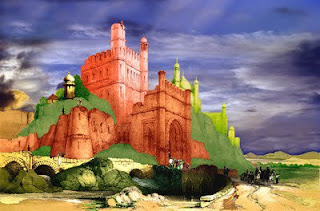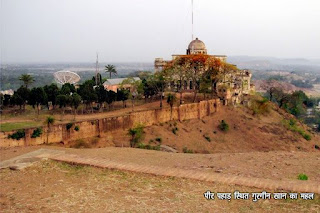Hi Readers,
This story is a brief of the story in Chandogya Upanisad, on Sage Uddalak's teaching on oneness of the soul.
Have you ever wondered who and where is God? Why can we not see Him? How did he create the world? Here is a story from the Chandogya Upanishad which answers your doubts.
Long, long ago, there lived a sage named Uddalaka. He had a son named Swetaketu. When Swetaketu was seven years old, Uddalaka invested him with the sacred thread and sent him to a gurukul to continue his studies under a suitable guru.
Swetaketu was a bright and diligent student, and learnt all he could from his guru, pleasing everyone at the gurukul. Finally, his studies complete, he returned home, bursting with pride at his achievement.
Uddalaka saw his son approaching the ashram, and realized at once that his son had returned filled with pride and ego. He was saddened, for true learning and knowledge brings not pride, but humility. A true scholar is one who has subdued his ego and humbly bows before the Supreme.
Uddalaka decided that he would have to complete his son’s education himself, and called Swetaketu. The boy arrived with a smile, ready to tell his father about all that he had learnt and all the praises he had received.
Swetaketu was received by his father with a question. “My son,” said Uddalaka “I am sure you have learnt all there is to learn at the gurukul. Do you now have the knowledge by which one can hear what can not be heard, by which one can see what can not be seen, and by which one can know what can not be known?”
Swetaketu was not only stunned, but also confused by his father’s question. How could one hear that which could not be heard, see what could not be seen, or know what could not be known? His father was a great rishi. Surely he had some knowledge that he hadn’t learnt so far. Part of his pride fell away as he asked his father respectfully, “Father, I do not have the knowledge of what you speak. Can you please explain this to me, since I do not understand?”
Uddalaka replied, “My son, I am talking about that which is inherent in all things. For example, once you have seen a lump of clay, you can recognize all objects made of clay. Similarly, once you have seen a nugget of gold, you can identify all items made of gold. In the same way, once you have seen a piece of iron, you can recognize all objects made of iron, no matter how different they may seem. For, it is not the shape, size or use of the object, but what they are made up of, which is important. Similarly, everything in the universe has different names and forms, but there is something inherent in all of them. Do you know what that is?”
Swetaketu bowed before his father and said, “Father, I do not know of these things. Perhaps my gurus too did not know of this, for if they had, they would surely have taught it to me. Please teach me this knowledge of which you speak.”
Pleased with his son’s humble request, Uddalaka said, “Listen, my son, I shall tell you how this world was created. In the beginning, there was only the ‘Sat’ or the One True Being. Having decided to create other beings, he first created Tejas (Fire), Apas (Water) and Annam (Food). Entering them as the Jivatma (Soul), he brought them to life and gave them name and form. He then decided to multiply further, and made them merge in different ratios to create more beings. These are what we know by various names today as Indra, Surya, and others.”
The rishi continued, “The three basic forms had merged to create more forms, but the basic nature of the three constituents were retained. Agni or fire showed itself as the red colour, while water showed itself as white and food as black. Even in their new forms, they showed themselves, for example, in the sun, what we call Surya or Aditya, the red colour is due to the fire, the white due to water and black due to food or earth.”
The sage explained further, “The basic forms of all beings are only the first three forms to be created – Tejas, Apas and Annam. Even in these three forms, it is the Sat, the True Being, who is the one form within all these three. Thus, the Sat alone is all, for all are different names for Him!”
Uddalaka concluded, “My son, the Sat is all powerful, for all beings are just His reflections. We call Him by many names, the True Being, the Supreme, and the Brahman. But they are all just different names for the all powerful One who is the essence of all life. Once we know Him, we know everything else. It is from Him that we all are born, and it is into Him that we merge when we die. We come into contact with Him within ourselves when we meditate. He pervades all and destroys all. He is the only perfect One. My dear son, you are not Him!”
Swetaketu was humbled by his father’s words, for he realized how little he knew. He said, with folded hands, “Father, please tell me more about the Supreme Being, for I want to know more about Him.”
Uddalaka was happy to see that his son was showing the signs of humility and a desire for knowing the real truth. He said, “My son, observe how the bees collect nectar from different flowers and make honey in their hive. Is it possible to distinguish the nectar of the different flowers from the honey? So also, we are all different, but in essence, it is the one true being that unites us all!”
He continued, “My son, see the rivers which merge into the sea. The waters of the different rivers appear different. But the sea into which the merge does not change. So also, we are all different forms of the true being. We appear different due to our forms, but we arise from the same source, and merge into the same – which is the Supreme!”
The sage then asked Swetaketu to bring a fruit and cut it into two. Uddalaka asked, “What do you see?” Swetaketu replied, “I can see seeds.” Uddalaka said, “Cut a seed into two and tell me what you see.” Swetaketu replied, “Father, there is nothing inside the seed.” Uddalaka smiled and replied, “Son, you can not see anything inside this seed, but from this tiny seed sprouts a huge tree. So also from the One True Being sprouts the entire universe!”
Next, Uddalaka asked Swetaketu to bring a glass of water and some salt. He asked Swetaketu to put the salt in the water and asked, “Can you see the salt now? Can you take it out?” Swetaketu replied, “Father, I can not see the salt, for it has dissolved in the water, and I can not take it out.” Uddalaka now asked Swetaketu to take a sip from the glass. Swetaketu replied, “The water is salty.” Uddalaka asked Swetaketu to taste the water from all portions of the glass, and Swetaketu replied that the water tasted salty everywhere. Uddalaka explained, “My son, you can not see the salt, but you can taste it. Similarly, the Supreme being pervades every atom of this universe, even though we can not see Him.”
Swetaketu understood at last the significance of Sat, and felt humble as he realized the magnitude of the One True Being. In course of time, he became a great rishi himself.
Thus, we too should understand that the only perfect one is the Lord, and all we see around us are His forms. We are, but tiny specks of his creation, and must remember this and learn to be humble. Humility is indeed the greatest of all virtues, for only then can we realize the truth.




































































